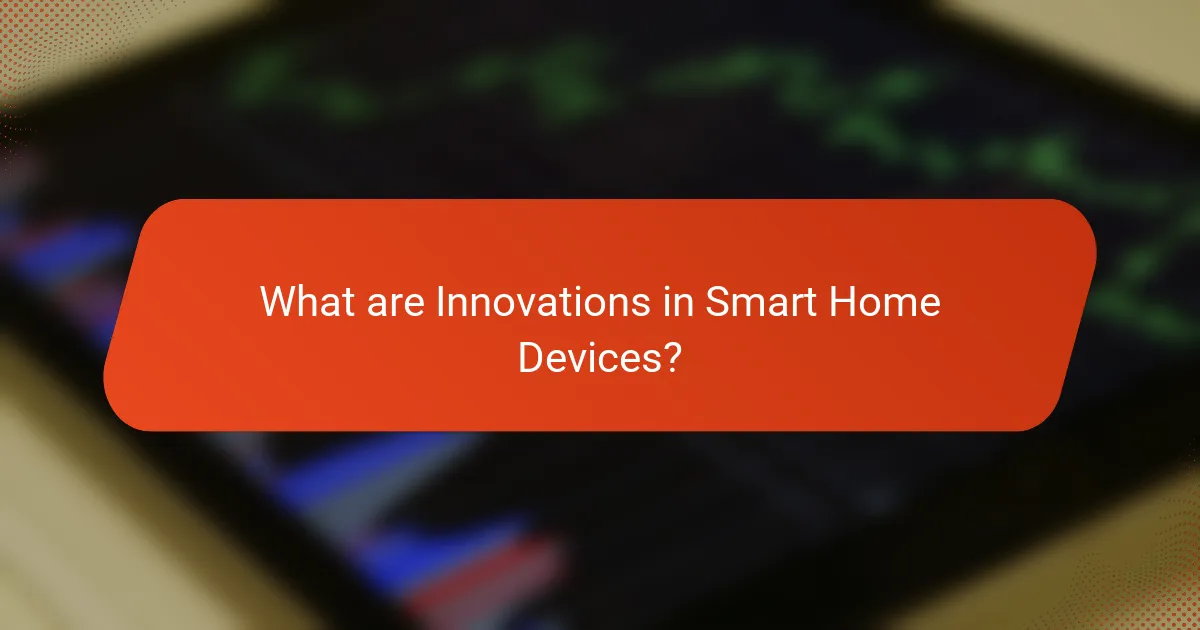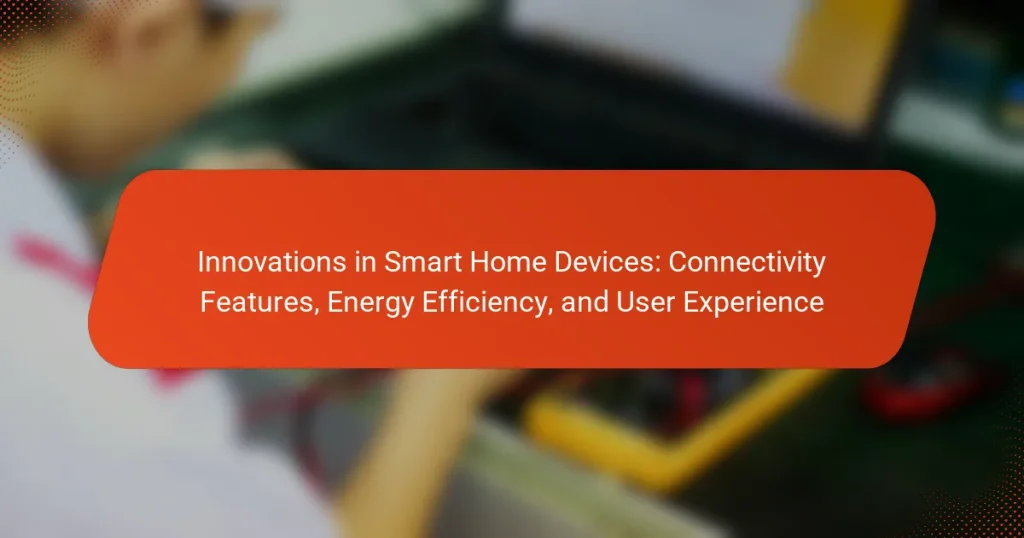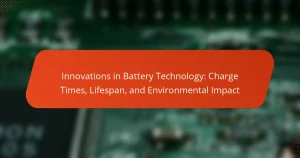Innovations in smart home devices focus on three key areas: enhanced connectivity, improved energy efficiency, and advanced user experience features. Enhanced connectivity is facilitated by technologies such as Wi-Fi 6 and Zigbee, which enable more efficient communication between devices. Energy efficiency improvements are exemplified by smart thermostats that adjust heating and cooling based on user behavior. Additionally, advanced user experience features include intuitive interfaces and voice control capabilities, making these devices more user-friendly. The global smart home market is anticipated to grow significantly, reaching $174 billion by 2025, reflecting the increasing influence of these innovations.

What are Innovations in Smart Home Devices?
Innovations in smart home devices include enhanced connectivity, improved energy efficiency, and advanced user experience features. Enhanced connectivity is achieved through technologies like Wi-Fi 6 and Zigbee, allowing devices to communicate more efficiently. Improved energy efficiency is evident in smart thermostats that optimize heating and cooling based on user behavior. Advanced user experience features involve intuitive interfaces and voice control capabilities, making devices easier to use. According to a report by Statista, the global smart home market is projected to reach $174 billion by 2025, highlighting the growing impact of these innovations.
How do Smart Home Devices enhance connectivity?
Smart home devices enhance connectivity by integrating various technologies to create a cohesive network. They utilize Wi-Fi, Bluetooth, and Zigbee protocols to communicate with each other and with users. This integration allows devices to share data seamlessly. For example, smart speakers can control lights and thermostats through voice commands. Additionally, these devices can be managed remotely via smartphone apps. According to a report by Statista, the global smart home market is expected to reach $174 billion by 2025, indicating increasing adoption. Enhanced connectivity improves user convenience and automation, making daily tasks more efficient.
What technologies enable connectivity in Smart Home Devices?
Smart home devices utilize several technologies to enable connectivity. These include Wi-Fi, Bluetooth, Zigbee, and Z-Wave. Wi-Fi provides high-speed internet access for devices and allows remote control via smartphones. Bluetooth facilitates short-range communication between devices, ideal for quick connections. Zigbee and Z-Wave are low-power communication protocols designed for home automation. They enable devices to communicate over longer distances with low energy consumption. According to the Consumer Technology Association, these technologies enhance interoperability among smart devices. This connectivity allows for seamless integration and control within smart home ecosystems.
How do different connectivity protocols impact device performance?
Different connectivity protocols significantly impact device performance. Protocols like Wi-Fi, Zigbee, and Bluetooth offer varying data transfer speeds, range, and energy consumption. Wi-Fi provides high-speed internet access but can drain battery life quickly. Zigbee operates on low power, making it ideal for energy-efficient devices, but has lower data rates. Bluetooth offers moderate speeds and is suitable for short-range connections. The choice of protocol affects latency, reliability, and overall user experience. For instance, a study by the International Journal of Computer Applications found that devices using Zigbee showed a 60% reduction in energy consumption compared to Wi-Fi devices. Thus, selecting the right protocol is crucial for optimizing device performance in smart home environments.
What role does energy efficiency play in Smart Home Devices?
Energy efficiency is crucial in smart home devices as it reduces energy consumption and lowers utility costs. These devices often utilize advanced technologies to optimize energy use. For example, smart thermostats can learn user habits and adjust heating or cooling accordingly. This can lead to energy savings of up to 10-15% annually. Additionally, energy-efficient smart appliances consume less power while maintaining performance. The integration of energy monitoring features allows users to track usage patterns in real-time. According to the U.S. Department of Energy, smart home technologies can significantly enhance overall energy efficiency in households. This not only benefits consumers financially but also contributes to environmental sustainability by reducing carbon footprints.
How do Smart Home Devices contribute to energy savings?
Smart home devices contribute to energy savings by optimizing energy consumption. They utilize sensors and automation to manage lighting, heating, and cooling efficiently. For example, smart thermostats can learn user patterns and adjust temperatures accordingly. This can lead to a reduction in heating and cooling costs by up to 15%. Smart lighting systems can automatically turn off when rooms are unoccupied, further minimizing energy waste. Additionally, devices can provide real-time energy usage data, allowing users to identify and reduce unnecessary consumption. Studies show that households using smart home technology can save an average of 10-30% on energy bills annually.
What are the most energy-efficient Smart Home Devices available?
The most energy-efficient smart home devices available include smart thermostats, smart LED bulbs, and energy monitoring plugs. Smart thermostats, like the Nest Learning Thermostat, can save up to 15% on heating and cooling costs. Smart LED bulbs use up to 80% less energy than traditional incandescent bulbs. Energy monitoring plugs help track energy consumption and can reduce usage by up to 10% when used to manage devices. These devices not only enhance convenience but also significantly lower energy bills.
How do Smart Home Devices improve user experience?
Smart home devices improve user experience by providing convenience, automation, and enhanced control. They enable users to manage multiple appliances through a single interface. This centralization simplifies daily tasks. Smart devices can be programmed to operate automatically based on user preferences. For example, smart thermostats adjust temperatures according to user schedules. Voice assistants allow for hands-free operation of various devices. Studies show that 70% of users report increased satisfaction with smart home technology. Additionally, real-time monitoring provides users with insights into their energy consumption. This data helps users make informed decisions, further enhancing their experience.
What features enhance user interaction with Smart Home Devices?
Voice control enhances user interaction with smart home devices. It allows users to operate devices hands-free. Popular voice assistants include Amazon Alexa and Google Assistant. These systems recognize natural language commands. Users find this feature convenient for multitasking. Mobile app integration also improves interaction. Users can control devices remotely through smartphone applications. This offers flexibility in managing home systems. Automation features enhance user experience further. Users can set schedules for devices to operate automatically. Customizable notifications keep users informed about device status. Together, these features create a seamless and engaging user experience.
How does user feedback influence Smart Home Device design?
User feedback significantly influences Smart Home Device design by guiding improvements and feature development. Manufacturers collect feedback through surveys, reviews, and user testing. This data reveals user preferences and pain points. For instance, feedback may highlight the need for simpler interfaces or enhanced connectivity. Designers use this information to create more intuitive devices. As a result, devices become more user-friendly and efficient. A study by the Consumer Technology Association found that 70% of consumers prefer devices that evolve based on user input. This demonstrates the importance of integrating user feedback into the design process.
How do connectivity features affect the overall functionality of Smart Home Devices?
Connectivity features significantly enhance the overall functionality of smart home devices. These features enable devices to communicate with each other and with users seamlessly. For instance, Wi-Fi and Bluetooth connectivity allow for remote control and automation. Devices can be integrated into a unified system, improving user experience and efficiency.
Research shows that homes with interconnected devices can achieve up to 30% energy savings. This is due to optimized performance and reduced energy consumption. Additionally, connectivity allows for real-time monitoring and alerts, enhancing security. The ability to update software remotely also ensures devices remain functional and secure over time. Overall, connectivity features are essential for maximizing the capabilities and benefits of smart home devices.
What advancements are being made in energy efficiency for Smart Home Devices?
Advancements in energy efficiency for smart home devices include the development of low-power communication protocols. These protocols, such as Zigbee and Z-Wave, reduce energy consumption during data transmission. Energy-efficient microcontrollers are also being integrated, which lower power usage significantly. Smart devices now utilize machine learning algorithms to optimize energy consumption based on user behavior.
Additionally, many devices feature energy monitoring capabilities, allowing users to track and manage usage more effectively. The implementation of renewable energy sources, like solar panels, is also becoming more common in smart home systems. Enhanced insulation and energy-efficient appliances contribute further to overall energy savings.
These advancements collectively aim to lower energy bills and reduce environmental impact, making smart homes more sustainable.
What specific user experience improvements can be expected from the latest Smart Home Devices?
Latest smart home devices enhance user experience through improved automation, seamless connectivity, and intuitive interfaces. Automation allows devices to learn user preferences and adjust settings accordingly. Seamless connectivity enables devices to communicate effectively, reducing latency and enhancing responsiveness. Intuitive interfaces simplify control, making it easier for users to manage multiple devices. Enhanced security features provide peace of mind through real-time alerts and remote monitoring. Voice control integration allows for hands-free operation, increasing convenience. Energy management features help users track and reduce consumption, promoting sustainability. These improvements collectively lead to a more efficient and enjoyable smart home experience.
How can users maximize the benefits of Smart Home Devices?
Users can maximize the benefits of Smart Home Devices by integrating them into a cohesive ecosystem. This involves selecting devices that are compatible with one another. For instance, using a smart hub can centralize control of all devices. Regularly updating device firmware ensures optimal performance and security. Users should also utilize automation features to create schedules and routines. This can enhance energy efficiency by reducing unnecessary usage. Monitoring energy consumption through smart devices provides insights for better management. Additionally, leveraging voice control and mobile apps can improve user experience. Customizing settings based on personal preferences can further enhance functionality and convenience.
What are common troubleshooting tips for Smart Home Devices?
Common troubleshooting tips for smart home devices include checking the power source, ensuring Wi-Fi connectivity, and restarting the device. Verify that the device is plugged in and powered on. Check your internet connection to confirm it is stable. Restarting the device often resolves temporary glitches. Update the device’s firmware to ensure it has the latest features and security patches. Review the manufacturer’s instructions for specific reset procedures if needed. Ensure that the device is within range of the Wi-Fi router to maintain a strong signal. Finally, check for interference from other devices that might affect connectivity.
Innovations in smart home devices focus on three primary areas: connectivity features, energy efficiency, and user experience. Enhanced connectivity is facilitated by technologies such as Wi-Fi, Bluetooth, and Zigbee, enabling seamless communication among devices and improving automation. Energy efficiency is achieved through advanced features like smart thermostats and energy monitoring, which significantly reduce consumption and costs. User experience is enhanced through intuitive interfaces, voice control, and automation, allowing for more convenient and efficient management of home systems. The article provides a comprehensive overview of these innovations and their impact on the growing smart home market.




